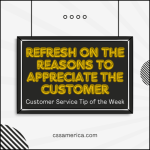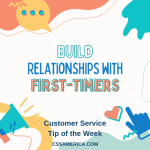With all due respect to the movie Jerry Maguire, this tip is not about the life of agents for professional athletes. It’s about customer service and what it really means to help.
We’ve seen employees wear badges that say “Ask me. I am happy to help!” or “May I help you?” or “How can we help you today?”
But what are we signing up for when we ask these questions or make these statements? Although the badge conveys our willingness to help and solicits questions from customers, what are we offering to do?
We are offering to provide information, to share our knowledge, to understand their unique needs and guide them toward the right solution. These actions require a desire to take action on the customer’s behalf, a willingness on our part to continually learn about our role, our services, our organization, and the ability to ask the right questions, matching the need with a solution.
We are offering to overcome obstacles or eliminate roadblocks. We are there to help them move to a next step or get through their day in a positive way. We are there to find pathways to Yes rather than roadblocks of No’s. These actions require a desire to address problems, to think through processes from the customer’s perspective, and to be pleasant in our engagement with others.
Being helpful may seem like a simple concept, but to truly help others, we need to have the desires, the willingness, the knowledge, and the ability to have a positive influence on those that we come in contact with each day.
Make sure that you’re equipped to truly help the customer today.
Signup for FREE Tips! Contact Us More Resources for You Visit Our Home Page























